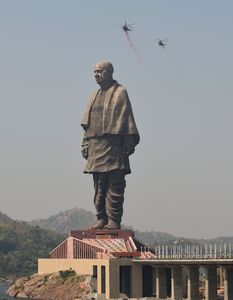Pay no attention to what the critics say, a statue has never been erected in honour of a critic.”
Jean Sibelius, the Finnish composer, was not, of course, saying this about the critics of the just inaugurated Statue of Unity. But, he, to their disappointment, would not have had anything else to say had he got the opportunity to address them.
Critics have this monumental ability to rise above their petty differences and unite to criticise everything that happens for the greater cause. And, so is the case with the Statue of Unity. The 182m statue, the tallest in the world,—inaugurated by Prime Minister Narendra Modi in Gujarat on the 143rd birth anniversary of Sardar Vallabhbhai Patel—cannot be looked at solely through the prism of economics.
Patel is one of the tallest and most underrated leaders in modern history, as propagated in post-Independence India by the ruling class. To understand Patel’s contributions, one needs to understand the difficult history of his time.
On the midnight of August 15, 1947, the British left a territory that comprised two kinds of political entities—the British provinces, administered directly by the British; and the princely states administered indirectly through princes. Apart from these, there were enclaves controlled by different European countries.
The eleven British provinces instantly became constituents of the Union of India on August 15, 1947. But the 565 princely states held out. They harboured varied intentions—some wanted to remain independent, some wanted to form a confederation of princely states, while some others wanted to merge with Pakistan.
This uncertainty posed a grave threat to the unity of India between 1947 and 1949. It was a challenging time, and Patel— the home minister and the first deputy prime minister—rose to the occasion like a true leader. He travelled countrywide, held negotiations, pacified the apprehensive and, occasionally, convinced the obstinate with a hint of sabre-rattling.
He succeeded in convincing nearly all princes to sign the instrument of accession with India. The ones who did not—like the Nawabs of Junagarh and Hyderabad—faced military action. Hence, by 1949, all the states Patel was authorised to deal with had signed individual instrument of accession with the Union government. All except Jammu and Kashmir, which was under the direct control of prime minister Jawaharlal Nehru. The instruments of accession were later skillfully converted into full merger agreements, under which the princes had to forego all territorial and administrative rights over their erstwhile states.
Thus, Patel is the unquestionable architect of India, and it is only fitting that the towering man is honoured with a towering monument that will remind generations of his monumental contribution towards a united India. The Statue of Unity is a small tribute to his mega-abilities.
In this context, I find all opposition to this monument pharisaical. This statue represents our commitment to honour the true legacies of India and to carry them forward for posterity. Those who object to it on the ground of its cost and utility forget that the monument entails a wholistic development of the surrounding tribal areas and countryside with a network of expressways, tourism corridors, ecological parks and hospitality infrastructure that would create immense economic opportunities for the local population, without impinging on the ecology of the area.
Honouring national heroes and preserving their legacies cannot be seen in economic terms only. Rather, it must be seen as an emotional return of the debt that we all owe to the Iron Man of India.
Hence, like Sibelius, I would suggest people not to pay attention to such critics.
Lekhi is member of Parliament • forthwriteml@gmail.com


